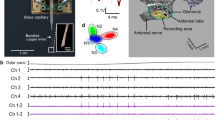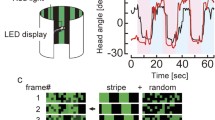Abstract
Time-dependent properties of chemical signals are probably crucially important to many animals, but little is known about the dynamics of chemoreceptors. Behavioral evidence of dynamic sensitivity includes the control of moth flight by pheromone plume structure, and the ability of some blood-sucking insects to detect varying concentrations of carbon dioxide, possibly matched to host breathing rates. Measurement of chemoreceptor dynamics has been limited by the technical challenge of producing controlled, accurate modulation of olfactory and gustatory chemical concentrations over suitably wide ranges of amplitude and frequency. We used a new servo-controlled laminar flow system, combined with photoionization detection of surrogate tracer gas, to characterize electroantennograms (EAG) of Drosophila antennae during stimulation with fruit odorants or aggregation pheromone in air. Frequency response functions and coherence functions measured over a bandwidth of 0–100 Hz were well characterized by first-order low-pass linear filter functions. Filter time constant varied over almost a tenfold range, and was characteristic for each odorant, indicating that several dynamically different chemotransduction mechanisms are present. Pheromone response was delayed relative to fruit odors. Amplitude of response, and consequently signal-to-noise ratio, also varied consistently with different compounds. Accurate dynamic characterization promises to provide important new information about chemotransduction and odorant-stimulated behavior.




Similar content being viewed by others
Abbreviations
- PID:
-
Photoionization detector
- EAG:
-
Electroantennogram
- ppm:
-
Parts per million
- OR:
-
Odorant receptor
References
Alcorta E (1991) Characterization of the electroantennogram in Drosophila melanogaster and its use for identifying olfactory capture and transduction mutants. J Neurophysiol 65:702–714
Barrozo RB, Kaissling KE (2002) Repetitive stimulation of olfactory receptor cells in female silkmoths Bombyx mori L. J Insect Physiol 48:825–834
Barrozo RB, Lazzari CR (2006) Orientation response of haematophagous bugs to CO2: the effect of the temporal structure of the stimulus. J Comp Physiol A 192:827–831
Bau J, Justus KA, Cardé RT (2002) Antennal resolution of pulsed pheromone plumes in three moth species. J Insect Physiol 48:433–442
Bendat JS, Piersol AG (1980) Engineering applications of correlation and spectral analysis. Wiley, New York, pp 1–302
Benton R (2007) Sensitivity and specificity in Drosophila pheromone perception. Trends Neurosci 30:512-519
Carlsson MA, Hansson BS (2002) Responses in highly selective sensory neurons to blends of pheromone components in the moth Agrotis segetum. J Insect Physiol 48:443–451
Cooley JW, Tukey JW (1965) An algorithm for the machine calculation of complex Fourier series. Math Comput 19:297–301
Dobritsa AA, van der Goes van Naters W, Warr CG, Steinbrecht RA, Carlson JR (2003) Integrating the molecular and cellular basis of odor coding in the Drosophila antenna. Neuron 37:827–841
French AS, Meisner S (2007) A new method for wide frequency range dynamic olfactory stimulation and characterization. Chem Senses 32:681–688
Geier M, Bosch OJ, Boeckh J (1999) Influence of odour plume structure on upwind flight of mosquitoes towards hosts. J Exp Biol 202:1639–1648
Golomb S (1967) Shift register sequences. Holden-Day, San Francisco, pp 1–224
Hallem EA, Ho MG, Carlson JR (2004) The molecular basis of odor coding in the Drosophila antenna. Cell 117:965–979
Hazel MH, Ianowski JP, Christensen RJ, Maddrell SH, O’Donnell MJ (2003) Amino acids modulate ion transport and fluid secretion by insect Malpighian tubules. J Exp Biol 206:79–91
Hedlund K, Bartelt RJ, Dicke M, Vet LEM (1996) Aggregation pheromones of Drosophila immigrans, D. phalerata, and D. subobscura. J Chem Ecol 22:1835–1844
Justus KA, Schofield SW, Murlis J, Cardé RT (2002) Flight behaviour of Cadra cautella males in rapidly pulsed pheromone plumes. Physiol Entomol 27:59–66
Justus KA, Cardé RT, French AS (2005) Dynamic properties of antennal responses to pheromone in two moth species. J Neurophysiol 93:2233–2239
Juusola M, French AS (1997) The efficiency of sensory information coding by mechanoreceptor neurons. Neuron 18:959–968
Juusola M, Niven JE, French AS (2003) Shaker K+ channels contribute early nonlinear amplification to the light response in Drosophila photoreceptors. J Neurophysiol 90:2014–2021
Karmeier K, van Hateren JH, Kern R, Egelhaaf M (2006) Encoding of naturalistic optic flow by a population of blowfly motion-sensitive neurons. J Neurophysiol 96:1602–1614
Kapitskii SV, Gribakin FG (1992) Electroantennogram of the American cockroach: effect of oxygen and an electrical model. J Comp Physiol A 170:651–663
Lucas P, Renou M (1992) Electrophysiological study of the effects of deltamethrin, bioresmethrin, and DDT on the activity of pheromone receptor neurones in two moth species. Pest Biochem Physiol 43:103–115
Mafra-Neto A, Cardé RT (1995) Influence of plume structure and pheromone concentration on upwind flight of Cadra cautella males. Physiol Entomol 20:117–133
Marmarelis PZ, Marmarelis VZ (1978) Analysis of physiological systems: the white-noise approach. Plenum Press, New York
Minor AV, Kaissling KE (2003) Cell responses to single pheromone molecules may reflect the activation kinetics of olfactory receptor molecules. J Comp Physiol A 189:221–230
Murlis J, Elkington JS, Cardé RT (1992) Odor plumes and how insects use them. Annu Rev Entomol 37:505–532
Shannon CE, Weaver W (1949) The mathematical theory of communication. University of Illinois Press, Urbana
Stensmyr MC, Giordano E, Balloi A, Angioy AM, Hansson BS (2003) Novel natural ligands for Drosophila olfactory receptor neurones. J Exp Biol 206:715–724
Vickers NJ, Christensen TA, Baker TC, Hildebrand JG (2001) Odour-plume dynamics influence the brain’s olfactory code. Nature 410:466–470
Willis MA, Baker TC (1984) Effects of intermittent and continuous pheromone stimulation on the flight behaviour of the oriental fruit moth, Grapholita molesta. Physiol Entomol 9:341–358
Yao CA, Ignell R, Carlson JR (2005) Chemosensory coding by neurons in the coeloconic sensilla of the Drosophila antenna. J Neurosci 25:8359–8367
Acknowledgments
Supported by the Canadian Institutes of Health Research and the Dalhousie Medical Research Foundation. The experiments complied with the “Principles of animal care”, publication No. 86-23, revised 1985 of the National Institute of Health, and were approved by the Dalhousie University Committee on Animal Care.
Author information
Authors and Affiliations
Corresponding author
Rights and permissions
About this article
Cite this article
Schuckel, J., Meisner, S., Torkkeli, P.H. et al. Dynamic properties of Drosophila olfactory electroantennograms. J Comp Physiol A 194, 483–489 (2008). https://doi.org/10.1007/s00359-008-0322-6
Received:
Revised:
Accepted:
Published:
Issue Date:
DOI: https://doi.org/10.1007/s00359-008-0322-6




